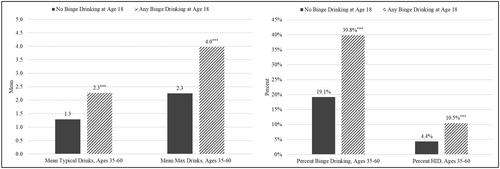Alcohol use is increasing among adults in midlife (i.e., ages 35–60), but few studies examine specific alcohol use behaviors in this age group. We examined measures of typical drinks, maximum drinks, binge drinking, and high-intensity drinking by age, sex, and race/ethnicity among midlife adults, as well as the prospective association between age 18 binge drinking and midlife behaviors.
Data from 5180 respondents participating in the national Monitoring the Future Panel study who were aged 35–60 in 2022 (followed since they were in 12th grade in 1980–2005) were used to estimate past 30-day midlife drinking behaviors (i.e., typical drinks, maximum drinks, binge, and high-intensity drinking) by age group, sex, and race/ethnicity. Associations between age 18 binge drinking status and midlife drinking outcomes were examined, as well as moderation by sociodemographic characteristics.
Across ages 35–60, the mean typical number of drinks on drinking days within the past month ranged from 1.4 to 1.8; the mean maximum drinks ranged from 2.3 to 3.2. Past-month binge and high-intensity drinking prevalence ranged from 19.1% to 31.2% and 3.6% to 8.1%, respectively. Estimates of drinking behaviors were generally higher among respondents aged 35–40 (vs. older age groups), males (vs. females), those identifying as White (vs. other racial/ethnic groups), and those who reported age 18 binge drinking (vs. not). Adolescent binge drinking was a stronger predictor of high-intensity drinking among females than males and of typical and maximum drinks among older (age 60) than younger (age 35) respondents.
Binge and high-intensity drinking were reported by a meaningful percentage of the US midlife adults. Binge drinking in adolescence was a predictor of subsequent alcohol-related risks. These long-term connections were especially strong among females. Age 18 binge drinking was a stronger predictor of high-intensity drinking at age 60 than earlier in midlife, underscoring that adolescent binge drinking is a key indicator of risk across the lifespan.


